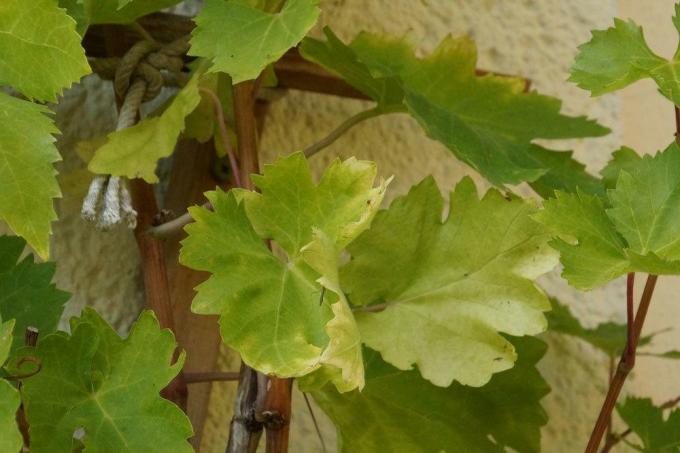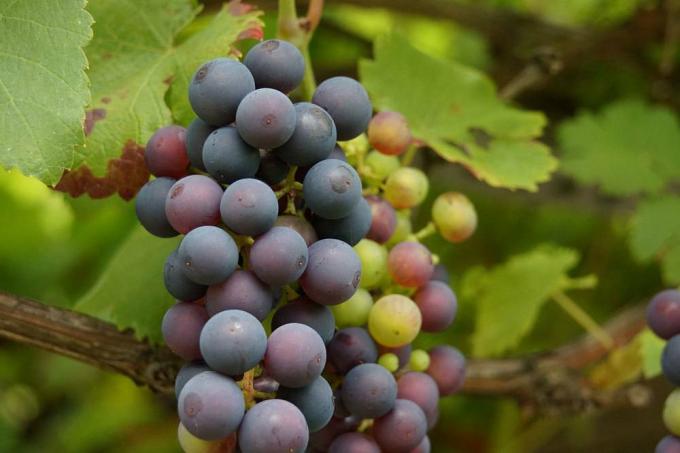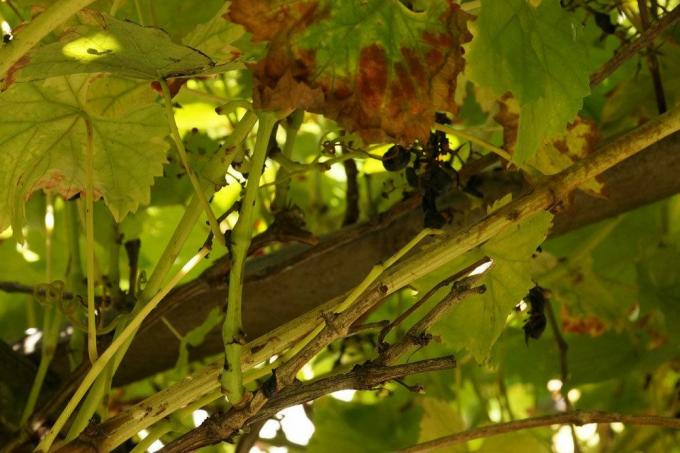
table of contents
- Grape varieties
- time
- Location
- floor
- plants
- Climbing aids
- Soil preparation
- Cuttings
- Preferred potted plants
- Potted plants
Own grapevines are a very special treat, not just for the eyes. Even if there are only one or two vines in your garden, they will deliver grapes year after year that are not only suitable for wine, but also as a fresh snack between meals. If the location of the vines has been well chosen and these are planted according to their needs, you can enjoy your pleasurable harvest for decades.
Grape varieties
Which vines to plant?
There are numerous grape varieties from all over the world, from the hybrids from the USA to the Classics like the Pinot Noir, but not all of these are suitable for the home garden. When selecting suitable grapes, the following aspects must be taken into account so that they can grow at all, let alone produce fruit efficiently.
- Frost hardiness
- Maintenance effort
- Fungus resistance
Due to the very high demands on the planting location, classic grape varieties that are used purely for viticulture are not always ideal for the garden. Especially if you don't have a lot of space or live in a cooler area of Germany, you should either plant vines instead of typical varieties are more robust than their relatives or table grapes, which due to their sweetness are less suitable for the production of wine, but all the more suitable for consumption are. Above all, these are well protected against diseases and pests, especially phylloxera and powdery mildew. The grape varieties are now described below.

Birstal nutmeg
- white, harvest time from mid-August to mid-September
Frumoasa alba
- white, harvest time in mid-September
Kischmisch Lutschistji
- rosé, harvest time in mid-September
Kodrianka
- blue, harvest time in mid-September
Muscat bleu
- blue, harvest time in early September
New York (Lakemont)
- white, harvest time from mid to late September
Ontario
- blue, harvest time in mid-September
Palatina
- white, harvest time early to mid-September
Pölöskei Nutmeg
- white, harvest time from late September to early October
regent
- blue, harvest time from mid-September
Vanessa
- red-rosé, harvest time at the beginning of September
Venus
- blue, harvest time from late August to mid-September
Elegant sverhranny
- white, harvest time in mid-August
Calastra
- white, harvest time from the beginning of September
Solotoi Don
- white, harvest time in mid-September
original
- rosé, harvest time at the beginning of October
Moldava
- blue, harvest time in mid-October
Of the above-mentioned grape varieties, Regent, Pölöskei Muscat and Muscat Bleu can be used for wine production without any problems. They have a more sour taste and, due to their later ripeness, are well suited for it. Although the yields are quite low and you get about a bottle of wine with four vines, the independent pressing is always worth an experience.

time
When is the best time?
Grapevines are only planted as soon as there is no longer any greater risk of frost, as this can be quite dangerous, especially for young plants. Even with varieties that are frost-hardy, you have to be careful to protect them from frost as a young specimen, as only the adult plants can withstand it. When is the best time to plant? The spring. During this time of year, you should keep the grapevines from mid-April to mid-May. Planting is also possible in early autumn, but you may only use bare-rooted vines during this time of year.
Location
The right location is particularly important for successful vine growth. Vitis vinifera is a sun worshiper par excellence and therefore feels extremely comfortable in full sun.
The following procurement of the planting location is important:
- Light requirement: sunny
- sheltered from the wind
- ideally in front of a wall facing S, SO, SW, W
- Trellis also possible
- The planting site can also be completely surrounded by walls
- often avoid temperatures below -15 ° C
- Late frosts
- early frost before autumn leaves fall
When planting the vines, it is less the when, but more the where. Without the right location with enough warmth, adequate air circulation and protection from wind and weather, the plants quickly die or suffer from pests such as the phylloxera. The right planting location also protects the sensitive grapevines in the cold season and ensures a corresponding microclimate that the vines need. Place the grapevines at a distance of at least eight inches from the wall so that they do not suffer from excessive moisture build-up or heat build-up.
Note: Please note that vines grow poorly from a height of about 400 meters above sea level. For this reason, locations in the Alps are much less suitable for garden vines than, for example, western Baden-Württemberg or the Palatinate.

floor
The soil for the vines is just as important as the correct planting location. Wine prefers soils that are not prone to waterlogging and are also air-permeable so that the roots do not suffocate.
Pay attention to the following soil properties:
- humus
- heavy sound
- loamy
- sandy
- relaxed
- permeable
- good ventilation
- pH value: between 5.0 and 7.5
- no stone floors
The ideal would be a soil whose soil is interspersed with a lot of humus, then the vines can withstand even harsher weather conditions. Also, make sure that the roots can dig deep into the ground, since grapevines are taproots. For this reason, stony soils are not suitable for the plants, except for the substrate, which is criss-crossed by fine rubble. The faster the soil can warm up after the cold season, the better the plants are doing.

plants
How is it planted?
Once you've decided on the right place, it's time to plant the vines. This is sometimes the most important point to enable healthy growth that enables juicy and tasty grapes. Due to the growth habit, you must pay attention to the following points in order to plant the vines successfully.
- Put on climbing aids
- Preparation of the soil
- Distance of the plants
- Plant cuttings
- Plant vines from the pot
Climbing aids
Grapevines are climbing plants that need a climbing aid in order to be able to grow in a targeted manner and to be protected from fungal infections. The suitable climbing aids are the following.
- Plant stakes
- free-standing trellises
- Trellis on the wall

Plant posts are the simplest variant for viticulture in the garden, as these are made available to the plant either individually or twice for tendrils. They are well suited for individual plants that are not to be integrated decoratively into the garden, while trellises are made of wire or wood in different shapes. While freestanding trellises can be set up anywhere in a convenient location, wall trellises must Maintain a distance of ten to twenty centimeters from the wall to prevent infestation by fungi, especially powdery mildew avoid.
Soil preparation
So that you can easily plant the vines in spring, you need to do the following tillage in autumn.
- Loosen the planting site about 40 centimeters deep
- put heavily rotted compost in the substrate
- the planting area should be about 20 by 30 centimeters
distances
The correct distance between the individual plants is important so that they can develop their full potential and also do not suffer from fungal diseases. The more space the vines have, the better the air circulates and the required microclimate is maintained. The distances in detail are listed below.
- Row planting: 1.5-2 m
- Arbor: 1 - 1.5 m
- Trellis: 1-1.5 m
- Horizontal cordon: 2 - 3 m
Cuttings
Cuttings: a guide
Cuttings work fine for planting, as long as you order some from a winemaker or nursery if you don't have any vines in your garden. You should also pay attention to the quality of the individual grape varieties, as you will only enjoy your products for so long. The cuttings should only be planted in the garden in spring, as they would not be able to withstand the onset of winter if they were planted in autumn.
Proceed as follows:
1. Step: Water the cutting well before planting it in the ground. The entire root ball must be completely wet in order to be supplied with moisture over a long period of time.
2. Step: Dig a planting hole 35 centimeters deep and make sure to keep the individual distances when planting several specimens, otherwise there may be a lack of space under the plants.
3. Step: Mix the excavated material with about one to two liters of high-quality potting soil and layer it as a cone in the planting hole. Place the cutting on this cone and carefully distribute the roots in all directions to optimize nutrient and water absorption.
4. Step: Make sure that the grafting point protrudes about three centimeters above the ground so that the roots are not too deep.
5. Step: Then fill in the rest of the substrate, pressing it down again and again. Be especially careful with the cuttings, you don't want to damage the roots. Layer up soil around the grafting point.
6. Step: Add water to flush existing holes at ground level.
7. Step: Don't forget your climbing aid!
Note: Never step on the earth. That would damage the roots.

Preferred potted plants
Preferred potted plants: a guide
It is easier for you if you buy the grapevines early and then put them in the garden. Of course, you should make sure that the vines are healthy. Vine nurseries that stock selected varieties and offer them in high quality are particularly suitable for this. You can put the pre-grown plants in the ground in autumn, as they are already slightly larger than the cuttings.
When planting, do the following:
1. Step: Prepare a vessel with water, preferably mineral or rainwater, to hold the root ball. Remove the plant from the supplied pot and place the vine in the container. Wait until the bale is completely soaked.
2. Step: Now place the vine so deep in the ground that the grafting point protrudes about three centimeters from it. Also make sure to distribute the roots evenly in the soil so that too many roots in one place do not affect the growth.
3. Step: If you pour it in abundantly, the substrate can better enclose the root ball and provide support.
4. Step: Pile up the grafting point with soil and continue with the usual care.

Potted plants
Grapevines in a pot: a guide
You can keep individual specimens in the bucket, for which you only need sufficient space and effective winter protection.
Proceed as follows:
- The pot must have a volume of at least 30 liters and have drainage holes
- fill this with high-quality potting soil and expanded clay in a ratio of 2: 1
- insert the plant so deep that the point of grafting protrudes about three centimeters above the surface
- use in winter with fleece and bubble wrap as protection
- don't forget a climbing aid that is placed directly in the bucket
Tip: Use an old barrel as a planter. This not only looks decorative, but also offers enough space for extensive growth and keeps the plant warm.



